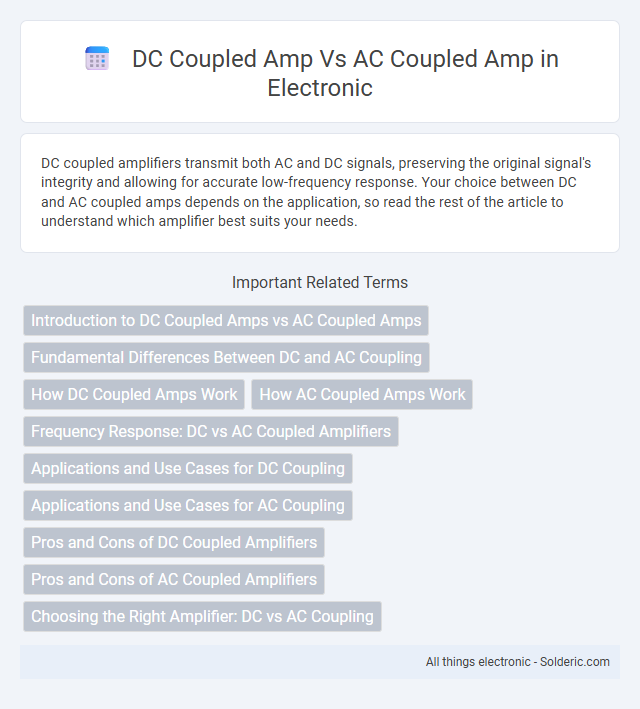DC coupled amplifiers transmit both AC and DC signals, preserving the original signal's integrity and allowing for accurate low-frequency response. Your choice between DC and AC coupled amps depends on the application, so read the rest of the article to understand which amplifier best suits your needs.
Comparison Table
| Feature | DC Coupled Amplifier | AC Coupled Amplifier |
|---|---|---|
| Signal Transmission | Passes both AC and DC components | Blocks DC component, passes only AC signals |
| Input Offset | May amplify DC offset, requires offset correction | No DC offset amplification due to capacitor coupling |
| Frequency Response | Wide frequency range including zero Hz (DC) | Lower cutoff frequency set by coupling capacitor |
| Application | Sensor signal amplification, precision measurement | Audio amplifiers, AC signal processing |
| Complexity | Requires careful offset management | Simple DC isolation with capacitor |
| Power Consumption | Generally higher due to offset management circuitry | Lower, simpler design |
| Signal Integrity | High fidelity for both AC and DC signals | May cause baseline shift or distortion in low frequency |
Introduction to DC Coupled Amps vs AC Coupled Amps
DC coupled amplifiers transmit both AC and DC signals without blocking low-frequency components, making them ideal for applications requiring accurate amplification of sensor outputs or biopotentials. AC coupled amplifiers use capacitors to block DC offset, effectively filtering out noise and drift but potentially losing low-frequency information. Your choice depends on whether preserving DC information or rejecting DC offsets is crucial for your signal processing needs.
Fundamental Differences Between DC and AC Coupling
DC coupled amplifiers directly transmit both AC and DC signals, preserving low-frequency components and allowing precise amplification of signals with varying baselines. AC coupled amplifiers use capacitive coupling to block DC components, enabling only AC signals to pass through, which eliminates DC offsets but limits low-frequency response. The fundamental difference lies in how each amplifier handles DC signals, impacting signal integrity, baseline drift, and frequency range in applications such as audio processing and sensor data acquisition.
How DC Coupled Amps Work
DC coupled amplifiers transmit both AC and DC signals by directly connecting the input to the amplifier stage without using coupling capacitors, preserving the low-frequency information and DC offset. This direct connection allows accurate amplification of signals with slow variations or steady-state voltages, essential in sensor and instrumentation applications. Unlike AC coupled amps, DC coupling prevents signal distortion caused by capacitor charging and discharging, resulting in a more faithful reproduction of the original input signal across a wide frequency range.
How AC Coupled Amps Work
AC coupled amplifiers use capacitors to block DC signals while allowing AC signals to pass, ensuring that only varying signal components are amplified. This coupling prevents DC offset from propagating through the circuit, maintaining signal integrity and protecting subsequent stages from DC bias. Your audio or sensor system benefits from reduced noise and improved performance when using AC coupled amps for dynamic signal processing.
Frequency Response: DC vs AC Coupled Amplifiers
DC coupled amplifiers provide a frequency response that includes low-frequency signals down to 0 Hz, making them ideal for applications requiring accurate representation of DC and near-DC components. AC coupled amplifiers use capacitive coupling to block DC content, resulting in a high-pass frequency response that eliminates low-frequency signals below the cutoff frequency determined by the coupling capacitor and input impedance. This difference impacts signal integrity, with DC coupling preserving the full spectrum and AC coupling filtering out drift or offset components.
Applications and Use Cases for DC Coupling
DC coupled amplifiers are essential in applications requiring accurate low-frequency or zero-frequency signal amplification, such as biomedical instrumentation and sensor signal conditioning. Their ability to transmit DC and low-frequency components without distortion makes them ideal for precision measurement systems, data acquisition, and control systems demanding stable baseline performance. In contrast, AC coupled amplifiers are generally used where DC offsets must be blocked to prevent saturation or drift in audio processing and communication circuits.
Applications and Use Cases for AC Coupling
AC coupled amplifiers are commonly used in applications where blocking DC voltage is essential to protect downstream components or to isolate signals, such as in audio equipment, communication systems, and sensor interfaces. These amplifiers are ideal for processing AC signals without interference from DC offsets, ensuring signal integrity in data acquisition and wireless transmission. Your system benefits from minimized low-frequency noise and baseline drift, which enhances performance in applications like RF circuits and biomedical signal processing.
Pros and Cons of DC Coupled Amplifiers
DC coupled amplifiers offer the advantage of accurately amplifying signals down to 0 Hz, making them ideal for low-frequency or DC signal applications such as sensor measurements and audio equipment with full bandwidth response. However, they can suffer from offset voltage drift and DC bias issues, potentially causing signal distortion or amplifier saturation over time. Your choice of amplifier should weigh the need for true low-frequency response against the complexity of managing DC offsets and thermal stability.
Pros and Cons of AC Coupled Amplifiers
AC coupled amplifiers effectively block DC offset and low-frequency noise, enhancing signal clarity in audio and communication systems. However, they may introduce phase shift and distort low-frequency signals, potentially impacting fidelity in precision measurements. Your choice depends on whether you prioritize eliminating DC components or preserving the integrity of low-frequency signals.
Choosing the Right Amplifier: DC vs AC Coupling
Choosing the right amplifier depends on your signal type and application requirements, with DC coupled amplifiers preserving low-frequency and DC components crucial for sensor and instrumentation signals. AC coupled amplifiers block DC offsets, ideal for audio and communication systems where eliminating DC drift enhances signal clarity. You should consider your need for frequency response and baseline accuracy to decide between DC coupling's full-spectrum integrity and AC coupling's noise rejection benefits.
DC coupled amp vs AC coupled amp Infographic

 solderic.com
solderic.com